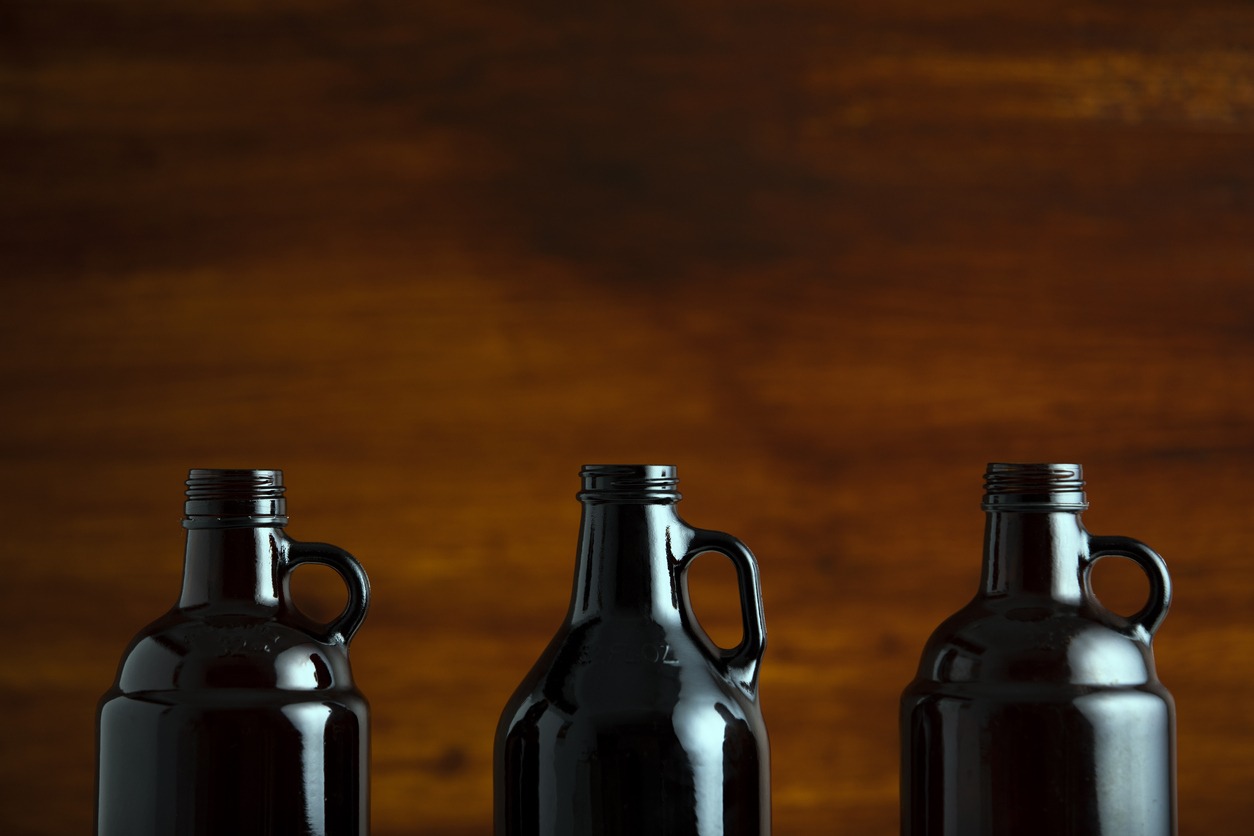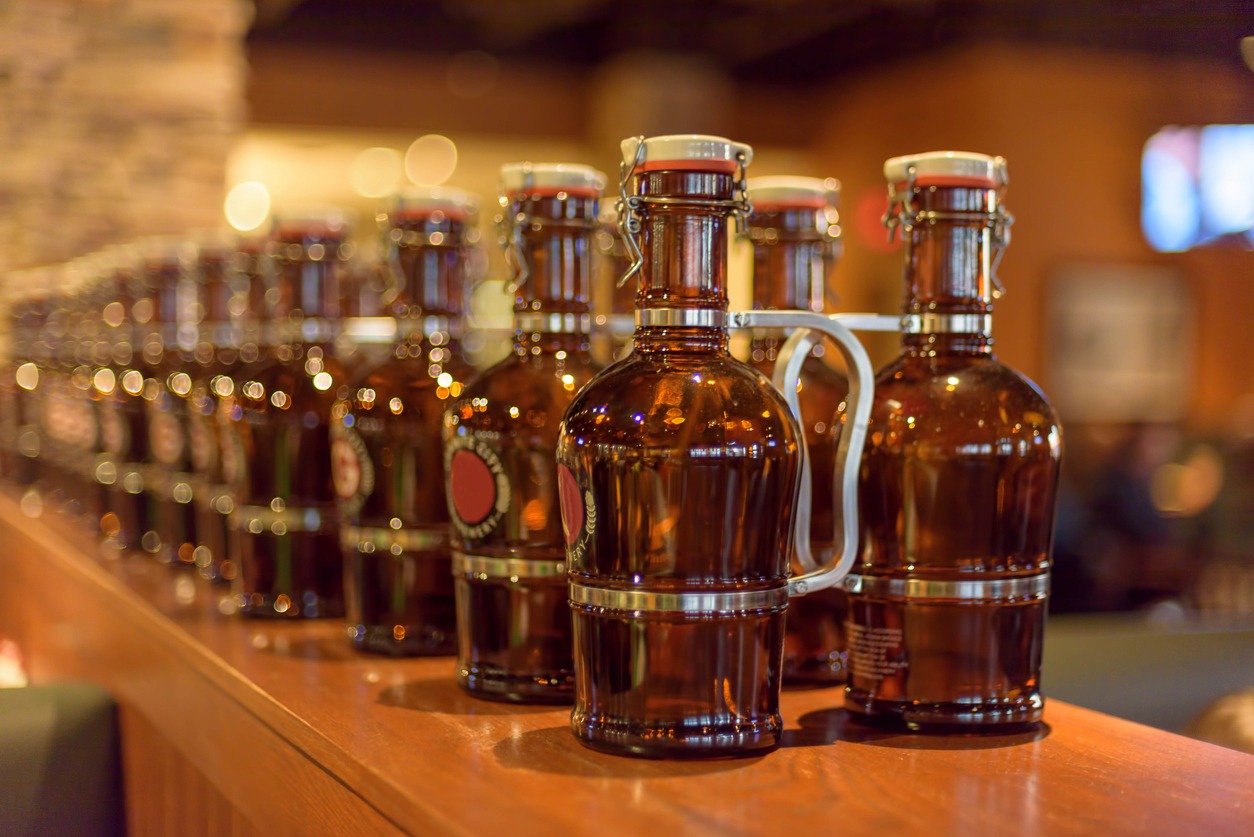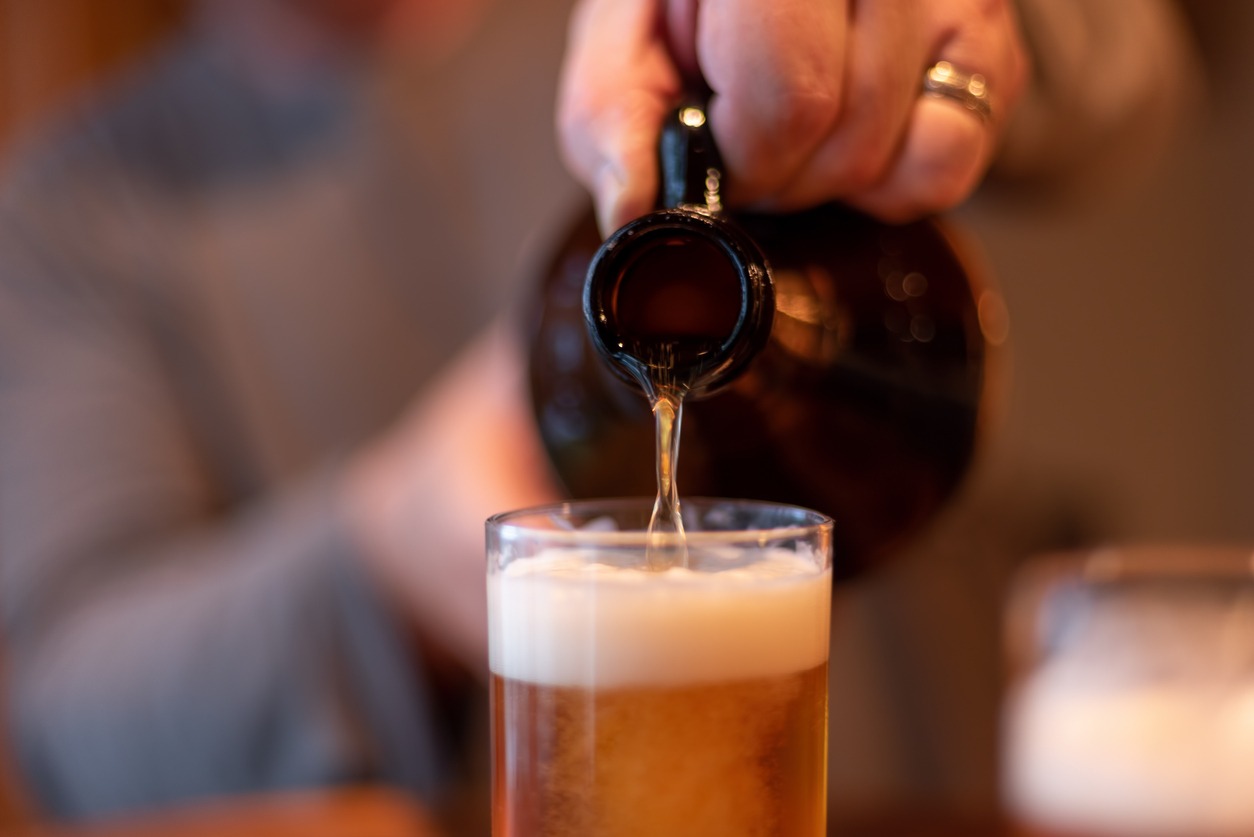With the craft beer industry booming, there’s a special container that beer enthusiasts love called the beer growler. It’s a bit unknown for many, but it’s cherished by those who enjoy freshly brewed ales and lagers. But what exactly is a beer growler, and why do people love it so much?
Let’s explore this beer vessel together and learn its history, its use, and why it’s so popular. We’ll also dive into the story behind its name and the special way people use it to enjoy and share their favorite beers.
What is a Beer Growler?
A beer growler is a container used to transport and store draft beer. It’s like an airtight jug made of materials such as glass, ceramic, stainless steel, or other materials designed to keep the beer fresh and carbonated. Buying draft beer from a store, restaurant, brew pub, or brewery is often poured from a keg using a tap system into these growlers.
Today, modern beer growlers are specifically designed to preserve the quality of craft beer and allow beer enthusiasts to take their favorite brews home from breweries, taprooms, or bars. They are often used for limited edition or small-batch beers that are not available in bottles or cans.
The purpose of a growler is to keep the beer fresh and tasty for some time, ranging from a few days up to a few weeks, depending on the type of growler and how it’s filled. Some growers have optional features that can extend the preservation time. Retailers may use CO2 to pump air out of the growler before filling it, which helps maintain the beer’s quality.
Beer growlers come in various sizes, typically ranging from 32 ounces (about 946 ml) to 64 ounces (about 1.9 liters), though some larger ones can hold up to 128 ounces (about 3.8 liters). They feature a secure, airtight seal, usually with a screw-on cap or swing-top lid, to maintain the beer’s freshness and carbonation during transportation.
How Did Beer Growler Get Its Name?
The true origin of the term “growler” remains a mystery, and it’s likely that we’ll never know the exact story. However, according to the tale that circulates, in the late 1800s, growlers were galvanized metal pails used to carry beer from local taverns to people’s homes. People would carry beer home from a tavern in these pails, which made a rumbling or growling sound as the carbonation escaped.
So, how did this clever little beer carrier earn its name? The term “growler” has its roots dating back to 1883 when early beer enthusiasts lugged their tin beer buckets all the way home. It’s said that these pails produced a grumbling noise due to the CO2 escaping through the lid, which led to the adoption of its name.
But there are other intriguing theories too! Some believe the name originated from the sound of a full pail being pushed down the bar by a bartender. Another suggestion proposes that “growler” comes from the buckets of beer given to workers to stave off hunger growls.
There are also some alternative theories that propose that the growling sound didn’t originate from the pail itself but rather from the dissatisfaction of either the bartender or the customer. Some claim it describes the grumpiness of someone who managed to drink all the beer inside. After all, “stumbler” or “pass-outer” just doesn’t have quite the same ring to it!
There’s also another story that goes to explain the origin of the name: that a bartender was supposed to fill the half-gallon container with just a pint of beer, while the customer, seeking more, wanted the pail to hold more than just a pint. As a result, whichever party ended up unsatisfied with the quantity of beer would “growl” in complaint, giving rise to the fitting name “growler.”
History of the Beer Growler
If you’re not familiar with the history of the growler, here’s a brief lesson. One theory dates back to the late 19th century when two-quart galvanized pails were used to carry beer between local pubs and homes. As the beer sloshed and CO2 was stirred, it produced a “growling” sound when gas escaped around the lid. The term “growler” for this container first appeared in Harper’s Magazine in July 1893.
In the early 20th century, the phrase “rushing the growler” emerged, describing how children would take a growler to a bar, fill it up, and then bring it to their father’s workplace in time for lunch. Some versions of this story suggest that the workers were so hungry by the time the growlers arrived that their stomachs would growl.
Another story from that era relates to the cost of “nickel beer” for a pint. Those who wanted a pint to-go would use a two-quart growler but only get a pint poured into it. This often led to disagreements between the bartender and the patron, causing some “growling” between the two.
Over time, the growler evolved into its modern-day version, like the 64-ounce glass jug. This innovation is credited to Charlie Otto, owner of Wyoming’s first draft-only microbrewery, Otto Brothers Brewery (now Grand Teton Brewing). In 1989, Charlie wanted a way for his customers to take his beer home, and his father remembered the old growlers. Charlie found half-gallon glass jugs, similar to moonshine jugs, and had his brewery’s logo printed on them, making history.
While the glass growler has remained mostly unchanged since 1989, there have been further developments, but their purpose remains the same: to transport beer from breweries, brewpubs, or bars to other places and preserve the beer’s quality for a reasonable time.
Different Types of Growlers
When it comes to beer accessories, there are several types of growlers you should know about. Understanding their differences will help you choose the right one for your needs.
- Glass growlers: Glass growlers are the most common type. You can find them in clear or amber glass, but it’s advisable to avoid clear glass as it exposes the beer to sunlight and harmful UV rays, making the beer more likely to go bad. The benefit of using a glass growler is that you can see the contents, making it easy to fill and track how much beer is left. However, glass growlers are fragile and prone to cracking or shattering if mishandled. They are best suited for careful use and not ideal for on-the-go activities.
- Stainless steel growlers: Stainless steel growlers are highly popular because they are durable and won’t break if accidentally dropped. They excel at insulation, keeping your beer colder for longer than other types. They are a great choice for outdoor activities like hiking, camping, or concerts since they are easy to carry around. However, the downside is that you can’t see the contents, making filling or monitoring the remaining beer slightly challenging.
- Ceramic growlers: Ceramic growlers are visually appealing and favored by some, but they are less common and often pricier. They may look great, but they tend to be heavy, making them less convenient to carry around. Cleaning them can also be a bit of a challenge due to the inability to see inside. Similar to glass and stainless steel growlers, ceramic ones are susceptible to chipping or breaking if mishandled. Despite these concerns, ceramic growlers still serve their purpose well. It is important to learn about where certain types of beers should be placed in different scenarios. For instance, there is a particular type of beer that is best enjoyed in a frosted glass. Learn more about it in our article, What’s the Single Best Beer to Enjoy in a Frosted Glass?
Benefits of Growlers
Beer growlers offer numerous advantages for beer enthusiasts. Here’s a quick overview of four benefits:
- Keeps beer fresh: Growlers are designed to be airtight, which helps preserve the beer’s carbonation and flavors for roughly ten days, allowing you to enjoy the beer over multiple servings.
- On-the-go enjoyment: Growlers are portable, allowing you to take your favorite beer to various events, gatherings, or outdoor activities like picnics, camping trips, or barbecues.
- Convenient transportation of draft beer: Growlers make it incredibly easy to carry draft beer with you. With their handles and manageable weight, you can transport multiple growlers effortlessly. Thanks to their airtight seals, the beer stays fresh even during transportation.
- Allows you to take home brewery-fresh beer: Owning a growler allows you to bring home beer directly from the local brewery. Enjoying that first sip of freshly tapped beer right from the source is a unique and delightful experience. Just check with the brewery beforehand to ensure they fill growlers and follow any specific guidelines they may have.
- Allows you to share your homebrew effortlessly: For homebrewers, growlers offer a simple way to share their creations with friends and family. Instead of bottling, which can be time-consuming, kegging the beer and filling up a growler is a convenient option for transporting and sharing your homebrewed beer.
- Ensures a steady beer supply: Growlers serve a practical purpose for bartenders and party hosts. When a keg starts running low, the remaining beer can be poured into growlers. This allows a new keg to be tapped without any interruption in service, ensuring a continuous and abundant supply of beer for customers or guests.
How to Fill a Beer Growler
Once your beer growler is clean and ready to go, the next step is finding a place that fills them. Not every bar that serves draft beer offers growler fills, but an internet search or asking the bartender at a craft beer-focused establishment should help you find a suitable place.
When you’ve located a filling spot, bring your growler in, let them know your beer choice, and pay attention to how they fill it. There are different methods of filling growlers, and it’s good to be aware of them:
1. Bottom-up filling
This is the most common method. The bartender attaches an extension tube to the faucet and inserts it into the growler, filling it from the bottom up, similar to bottling homebrew. While it reduces spillage and filling time, it may also increase the amount of oxygen inside the growler, potentially causing the beer to go stale faster.
2. Counter-pressure CO2 filling
Some places use a counter-pressure CO2 filler to minimize oxygen exposure. This system purges the oxygen from the growler before filling, helping to prevent beer oxidation and extending its freshness.
3. Pouring from the tap
This method involves simply holding the growler up to the beer faucet and pouring the beer directly into it. It creates a lot of foam and can result in wasted beer and a mess to clean up. Additionally, the beer inside the growler may not stay fresh for long. It’s not recommended and should only be used as a last resort.
Keeping Your Beer Growler Clean
It should be common sense, but surprisingly, many people neglect to clean their growlers after use. Failing to properly clean a growler can impact the true flavors and aromas of the beer as intended by the brewer. In worst-case scenarios, neglecting cleanliness can lead to mold and other unpleasant substances growing inside the growler, rendering your beer undrinkable.
Here’s how to maintain a clean growler:
- Rinse it quickly: Right after you finish the beer, give the growler a quick rinse with hot water. If you rinse it promptly, this simple step will suffice to get it ready for the next fill.
- Use cleaners: If the growler sits for a while before rinsing, you’ll need to use a cleanser to ensure a thorough cleaning. Avoid fat or oil-based soaps, as they may leave residues that can spoil your next fill. Homebrew cleansers are recommended if available.
- Consider using a brush: For stubborn dirt or grime, consider using a brush to scrub the interior. However, avoid using metal wire brushes on glass or ceramic growlers to prevent damage.
- Allow it to air-dry: After cleaning the inside, let the growler air-dry. Propping it upside down against a wall at an angle can speed up the drying process. Avoid using towels to dry the interior, as tiny fibers left behind can affect the quality of your next fill.
Some filling locations may offer to sanitize the growler for you. If that’s the case, take advantage of it for the best-tasting beer. However, not all places provide this service, so ensuring your growler is clean and ready before leaving your home is essential. If you find a place that offers sanitization, consider returning to them, as they know how to handle growlers properly.
Conclusion
Beer growlers are not just simple beer containers – they are vessels that carry a rich history, embodying the spirit of craft beer culture. From their mysterious origins in the late 19th century to the modern-day variations, growlers have become indispensable for beer enthusiasts, as it elevates their beer-drinking experience. If you love craft beer and exploring various breweries, investing in excellent, high-quality beer growlers can help you keep your craft beers fresh and tasty for longer!



